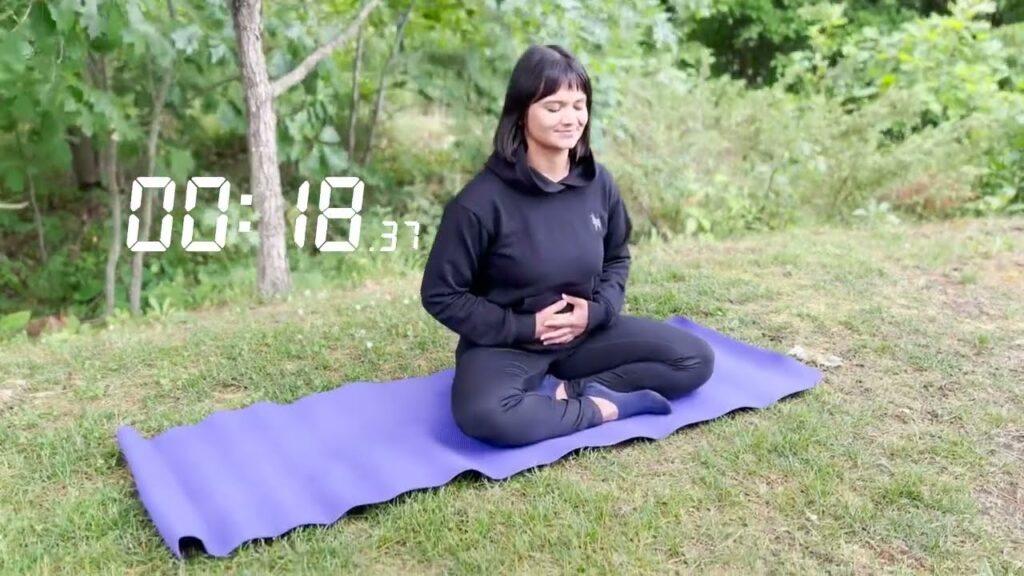Breathwork Can Help You Inhale and Exhale Your Way to a Better Mindset
In our fast-paced world, we often take breathing for granted. However, the simple act of conscious breathing can be a powerful tool for transforming our mental and physical well-being. Breathwork, the practice of intentional breathing exercises, offers a gateway to improved mindfulness, reduced stress, and enhanced overall health. This article explores the benefits of breathwork and provides practical exercises for both beginners and experienced practitioners.
The Benefits of Breathwork

Breathwork is more than just taking deep breaths; it’s a holistic approach to harnessing the power of our respiratory system for mental and physical betterment. By engaging in deliberate breathing exercises, we can tap into a wealth of benefits that positively impact our daily lives.
Stress Reduction and Relaxation
One of the primary advantages of breathwork is its ability to activate the parasympathetic nervous system, often referred to as the “rest and digest” mode. This physiological state promotes relaxation and counteracts the effects of stress on the body.
When we practice breathwork, we send signals to our brain that we are safe and in control. This triggers the release of acetylcholine, a neurotransmitter that slows heart rate, lowers blood pressure, and promotes proper digestion. As a result, we experience a sense of calmness and tranquility that can help us navigate stressful situations more effectively.
Regular breathwork practice can lead to long-term stress reduction, improving our overall quality of life and resilience in the face of challenges.
Enhanced Emotional Regulation
Breathwork serves as a powerful tool for managing emotions and improving our emotional intelligence. By focusing on our breath, we create a bridge between our conscious mind and our emotional state, allowing us to gain better control over our feelings.
Through consistent practice, we can learn to use breathwork as a means of emotional self-regulation. This skill becomes particularly valuable in high-pressure situations or when dealing with intense emotions. By turning to our breath, we can create a moment of pause, reassess our emotional state, and respond more thoughtfully rather than reacting impulsively.
Improved Mental Clarity and Focus
In today’s world of constant distractions, maintaining focus and mental clarity can be challenging. Breathwork offers a simple yet effective solution to this problem. By directing our attention to our breath, we train our mind to stay present and focused on the current moment.
Research has shown that regular breathwork practice can lead to improved cognitive function, including enhanced attention span, better decision-making abilities, and increased creativity. By incorporating breathwork into our daily routine, we can sharpen our mental faculties and approach tasks with greater clarity and efficiency.
Physical Health Benefits
The benefits of breathwork extend beyond mental well-being to include numerous physical health advantages. Proper breathing techniques can improve oxygen circulation throughout the body, leading to better overall health and vitality.
Some of the physical benefits associated with regular breathwork practice include:
- Improved cardiovascular health
- Strengthened immune system
- Better sleep quality
- Reduced inflammation in the body
- Enhanced athletic performance
By dedicating time to breathwork, we invest in both our mental and physical health, creating a foundation for overall well-being and longevity.
Breathwork Exercises for Beginners and Non-Beginners
Breathwork is a versatile practice that can be adapted to suit individuals at various levels of experience. Whether you’re new to the concept or have been practicing for years, there are exercises that can help you deepen your connection with your breath and reap the associated benefits.
Simple Awareness Breath
For beginners, the simple awareness breath is an excellent starting point. This exercise involves nothing more than bringing attention to your natural breathing pattern without attempting to change it.
To practice:
- Find a comfortable seated position or lie down.
- Close your eyes or soften your gaze.
- Begin to notice your breath as it enters and leaves your body.
- Observe the sensations of breathing without judgment.
- If your mind wanders, gently bring your attention back to your breath.
Practice this for 5-10 minutes daily to build a foundation for more advanced breathwork techniques.
Diaphragmatic Breathing
Diaphragmatic breathing, also known as belly breathing, is a fundamental technique that forms the basis of many breathwork practices. This exercise helps to engage the diaphragm fully, promoting deeper, more efficient breathing.
To practice:
- Lie on your back with your knees bent and feet flat on the floor.
- Place one hand on your chest and the other on your belly.
- Inhale slowly through your nose, allowing your belly to rise while keeping your chest relatively still.
- Exhale slowly through your mouth, feeling your belly lower.
- Repeat for 5-10 minutes, focusing on the movement of your belly.
Regular practice of diaphragmatic breathing can improve lung capacity and promote relaxation.
Alternate Nostril Breathing
For those looking to advance their practice, alternate nostril breathing is a powerful technique that can help balance the left and right hemispheres of the brain and promote a sense of calm.
To practice:
- Sit comfortably with your spine straight.
- Use your right thumb to close your right nostril.
- Inhale deeply through your left nostril.
- Close your left nostril with your ring finger and release your thumb.
- Exhale through your right nostril.
- Inhale through your right nostril.
- Close your right nostril and release your ring finger.
- Exhale through your left nostril.
- Repeat this cycle for 5-10 minutes.
As you become more comfortable with these exercises, you can explore more advanced techniques or increase the duration of your practice to deepen the benefits.
Box Breathing
Box breathing, also known as square breathing, is a simple yet powerful breathwork technique that can be particularly effective in managing stress and anxiety. This method involves creating a visual square with your breath, inhaling, holding, exhaling, and holding again for equal counts.
The Basics of Box Breathing
The fundamental structure of box breathing is straightforward:
- Inhale for a count of 4
- Hold the breath for a count of 4
- Exhale for a count of 4
- Hold the empty lungs for a count of 4
This creates a “box” or “square” pattern, hence the name. The simplicity of this technique makes it accessible to beginners while still offering benefits to more experienced practitioners.
How to Practice Box Breathing
To begin your box breathing practice:
- Find a comfortable seated position with your back straight.
- Close your eyes or soften your gaze to minimize distractions.
- Take a few natural breaths to settle into your body.
- Begin the box breathing pattern:
- Inhale slowly through your nose for 4 counts
- Hold your breath for 4 counts
- Exhale slowly through your mouth for 4 counts
- Hold your empty lungs for 4 counts
- Repeat this cycle for 5-10 minutes or until you feel calmer and more centered.
As you practice, focus on the sensation of your breath and the counting. If your mind wanders, gently bring it back to the breath without judgment.
Benefits of Box Breathing
Box breathing offers numerous benefits, making it a valuable tool for various situations:
- Stress Reduction: The regulated pattern of box breathing helps activate the parasympathetic nervous system, promoting relaxation and reducing stress.
- Improved Focus: By concentrating on the breath and counts, box breathing can enhance mental clarity and focus.
- Emotional Regulation: This technique can help manage strong emotions by creating a pause between stimulus and response.
- Better Sleep: Practicing box breathing before bed can help calm the mind and prepare the body for restful sleep.
- Anxiety Management: The structured nature of box breathing can provide a sense of control, helping to alleviate anxiety symptoms.
Incorporating box breathing into your daily routine can lead to long-term improvements in stress management and overall well-being.
Full Body Breathing
Full body breathing is an immersive breathwork technique that encourages a deep connection between the breath and the entire physical body. This practice not only enhances oxygen flow throughout the body but also promotes a heightened sense of body awareness and relaxation.
Understanding Full Body Breathing
Full body breathing involves visualizing and directing the breath to different parts of the body, creating a sense of expansion and release with each inhale and exhale. This technique combines elements of breathwork with body scan meditation, resulting in a comprehensive mind-body practice.
How to Practice Full Body Breathing
To begin a full body breathing session:
- Find a comfortable position, either lying down or seated with your spine straight.
- Close your eyes and take a few natural breaths to center yourself.
- Begin to deepen your breath, inhaling through your nose and exhaling through your mouth.
- As you inhale, imagine your breath flowing into your toes and feet.
- On the exhale, feel a sense of release and relaxation in your feet.
- With each subsequent breath, move your attention up through your body:
- Ankles and calves
- Knees and thighs
- Hips and lower back
- Abdomen and chest
- Shoulders and arms
- Neck and face
- Once you’ve reached the top of your head, reverse the process, moving back down through your body.
- Finish by taking a few breaths that encompass your entire body at once.
Practice this technique for 10-15 minutes, allowing yourself to fully explore the sensations in each part of your body.
Benefits of Full Body Breathing
Full body breathing offers a range of benefits that contribute to overall well-being:
- Increased Body Awareness: This practice helps develop a deeper connection with your physical self, promoting better body awareness and posture.
- Tension Release: By directing breath to specific areas, you can identify and release areas of tension or discomfort in the body.
- Improved Circulation: The focus on different body parts encourages blood flow and oxygen distribution throughout the body.
- Enhanced Relaxation: Full body breathing promotes a state of deep relaxation, reducing stress and promoting overall calmness.
- Mind-Body Integration: This technique strengthens the connection between mind and body, fostering a sense of wholeness and integration.
Regular practice of full body breathing can lead to a more balanced and harmonious relationship with your physical self, contributing to improved overall health and well-being.
3-Part Breath
The 3-part breath, also known as Dirga Pranayama in yoga traditions, is a fundamental breathwork technique that engages three main areas of the torso: the abdomen, chest, and upper chest or clavicular region. This practice promotes full, deep breathing and can serve as a foundation for more advanced breathwork exercises.
Understanding the 3-Part Breath
The 3-part breath involves filling and emptying the lungs in three distinct stages, creating a wave-like motion through the torso. This technique encourages the use of the full capacity of the lungs, promoting better oxygenation and a deeper connection with the breath.
How to Practice the 3-Part Breath
To begin practicing the 3-part breath:
- Find a comfortable seated position or lie on your back.
- Place one hand on your abdomen and the other on your chest.
- Begin with a few natural breaths to center yourself.
- Start the 3-part breath:
- Inhale into your abdomen, feeling it expand.
- Continue the inhale, filling your chest.
- Finally, allow the breath to reach your upper chest and clavicles.
- Exhale in reverse order:
- Release from the upper chest.
- Empty the chest.
- Finally, contract the abdomen to expel all the air.
- Repeat this cycle for 5-10 minutes, focusing on the smooth transition between each part of the breath.
As you become more comfortable with the technique, you can remove your hands and simply focus on the sensations of the breath moving through your body.
Benefits of the 3-Part Breath
The 3-part breath offers numerous benefits for both physical and mental well-being:
- Improved Lung Capacity: By engaging all areas of the lungs, this technique can increase overall lung capacity and efficiency.
- Stress Reduction: The rhythmic nature of the 3-part breath helps activate the parasympathetic nervous system, promoting relaxation and stress relief.
- Enhanced Oxygen Flow: This technique ensures that more oxygen is taken in and distributed throughout the body, potentially improving overall health.
- Increased Body Awareness: Practicing the 3-part breath develops a stronger connection between mind and body, enhancing proprioception and body awareness.
- Preparation for Meditation: This breathwork technique can serve as an excellent prelude to meditation practices, helping to calm the mind and center attention.
Regular practice of the 3-part breath can lead to improved respiratory function, reduced stress levels, and a greater sense of overall well-being. As you become more proficient, you may find that this technique becomes a natural and effortless way of breathing in your daily life.
Breathwork Can Be a Gateway to Meditation
Breathwork and meditation are closely intertwined practices that complement and enhance each other. For many, breathwork serves as an accessible entry point to the world of meditation, offering tangible techniques that can help quiet the mind and cultivate mindfulness.
The Connection Between Breathwork and Meditation
While breathwork focuses primarily on conscious control of the breath, meditation often involves observing the breath as an anchor for attention. Both practices aim to bring awareness to the present moment and foster a state of calm alertness.
Breathwork can be seen as a form of active meditation, where the manipulation of the breath serves as the object of focus. This can be particularly helpful for those who find it challenging to sit in stillness or struggle with racing thoughts during traditional meditation practices.
Using Breathwork to Enhance Meditation
Incorporating breathwork into your meditation practice can deepen your experience and help overcome common obstacles:
- Settling the Mind: Beginning your meditation with a few minutes of intentional breathwork can help calm mental chatter and create a conducive state for meditation.
- Maintaining Focus: When the mind wanders during meditation, returning to a specific breathing pattern can help re-center your attention.
- Managing Discomfort: If physical discomfort arises during meditation, breathwork techniques can help release tension and promote relaxation.
- Deepening the Practice: As you become more comfortable with both breathwork and meditation, you can explore how different breathing patterns affect your meditative state.
Transitioning from Breathwork to Meditation
To use breathwork as a gateway to meditation:
- Begin with 5-10 minutes of your preferred breathwork technique.
- As you feel your body and mind settling, gradually let go of controlling the breath.
- Allow your breath to return to its natural rhythm.
- Shift your focus to observing the breath without manipulation.
- If your mind wanders, gently bring your attention back to the sensation of breathing.
Start with short sessions and gradually increase the duration as you become more comfortable with the practice.
The Synergistic Benefits
When combined, breathwork and meditation offer a powerful toolkit for personal growth and well-being:
- Enhanced Self-Awareness: Both practices promote a deeper understanding of your mental and emotional states.
- Improved Emotional Regulation: The skills developed through breathwork and meditation can help manage stress and difficult emotions more effectively.
- Increased Mindfulness: Regular practice cultivates the ability to stay present and engaged in daily life.
- Better Sleep: The relaxation induced by these practices can lead to improved sleep quality.
- Physical Health Benefits: Both breathwork and meditation have been linked to various physical health improvements, including lower blood pressure and reduced inflammation.
By exploring the relationship between breathwork and meditation, you can develop a comprehensive practice that nurtures both body and mind, leading to greater overall well-being and personal growth.
Conclusion
Breathwork is a powerful and accessible tool for improving mental, emotional, and physical well-being. By incorporating intentional breathing exercises into our daily lives, we can tap into a wealth of benefits, from stress reduction and improved focus to enhanced emotional regulation and better physical health.
The techniques explored in this article – from simple awareness breathing to more advanced practices like box breathing, full body breathing, and the 3-part breath – offer a range of options suitable for both beginners and experienced practitioners. Each method provides unique benefits and can be tailored to individual needs and preferences.
Moreover, breathwork serves as an excellent gateway to meditation, allowing individuals to cultivate mindfulness and deepen their connection with the present moment. The synergy between breathwork and meditation creates a powerful foundation for personal growth and self-awareness.
As we navigate the challenges of modern life, the simple act of conscious breathing can become a source of strength, calm, and clarity. By dedicating time to explore and practice breathwork, we invest in our overall well-being and equip ourselves with a valuable tool for managing stress, improving focus, and enhancing our quality of life.
Remember, the journey of breathwork is personal and ongoing. Experiment with different techniques, be patient with yourself, and allow the practice to evolve naturally. With consistency and an open mind, you may find that breathwork becomes not just a practice, but a transformative way of living – one breath at a time.







